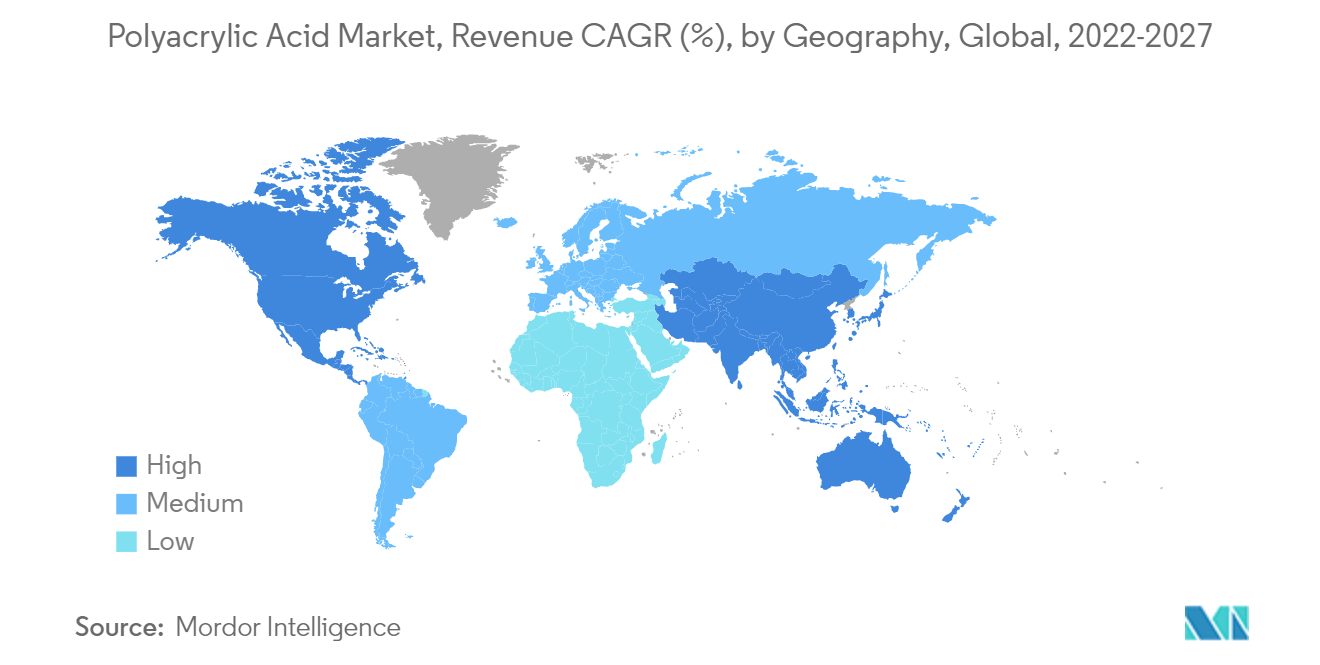Market Trends of Polyacrylic Acid Industry
This section covers the major market trends shaping the Polyacrylic Acid Market according to our research experts:
Rising Demand From the Water Treatment Industry
- The growing need for water conservation is expected to drive municipal and commercial water treatment projects in the future. Polyacrylic acid is primarily used as an anti-scaling agent in utilities such as cooling towers in industrial plants. It also finds application in water systems such as RO, evaporators in sugar industries, and desalination. In wastewater treatment, polyacrylic acid is also used as a clarifying agent for the removal of suspended solids.
- According to UNICEF, half of the world's population could be living in areas with water scarcity by the year 2025. As of 2022, over four billion people could already be experiencing a shortage of water for one month every year. Taking this into assessment, collective efforts have been made to reduce water usage and improve the recyclability of water.
- The industrial segment is one of the largest consumers of fresh water. According to the US EPA, as of 2022, industrial water use in the United States is estimated to be above 69 billion liters per day. With water conservation in focus, the National Water Reuse Action Plan (WRAP) was developed in collaboration with key players and partners across the water sector. In two years, WRAP accomplished the completion of five actions and 267 implementation milestones aimed at increasing water reuse across the country.
- The European Union has announced the Water Reuse Regulation effective from June 26, 2023, in a bid to encourage water reuse across the EU region. According to the European Commission, every year, about 1 billion cubic meters of treated urban wastewater is reused, with the European Union estimating the actual potential to be close to 6 billion cubic meters.
- Across the Asia-Pacific region, countries like China and India are actively planning and investing resources into recycling wastewater for agricultural, industrial, and domestic purposes, thereby developing strong opportunities for the water treatment industry across the region.
- With growing opportunities for the water treatment industry and polyacrylic acid finding major applications in the water treatment industry, the demand for polyacrylic acid is expected to be strengthened during the forecast period.

Asia-Pacific Region Set to Lead the Global Polyacrylic Market
- The rising population and growing industrial sector across the Asia-Pacific region are expected to favor the polyacrylic acid market. According to the IMF, the regional economic outlook looks promising for the Asia-Pacific region, with 6.5% growth recorded in 2021 and growth of 4% estimated for the year 2022.
- Major economies like China and India are witnessing a strong surge in industrial activity across the region. For instance, China's manufacturing output grew by 26.04% in 2021 compared to 2020. The increasing pressure on industries to reduce water consumption will boost demand for industrial water treatment programs with the rise in industrial activity.
- According to a report by NITI Aayog, the estimated wastewater generated in urban areas of India stands at 72,368 million liters per day (MLD), whereas rural areas generated wastewater at an estimated 39,604 MLD. The installed sewage treatment capacity is 31,841 MLD with an operational capacity of 26,869 MLD, which is not adequate to meet the present demand, with a gap of 79% remaining between installed capacity and actual load.
- Similarly, according to ITA, China accounts for close to 21% of the total global population but only has access to approximately 6% of the world's freshwater reserves. With already over 10,000 water treatment facilities present across the country, China intends to further increase its sewage treatment capacity by over 20 million m3/day through multiple projects and investments between 2021-2025.
- With most major economies taking due cognizance of the rising need for water recycling, the water treatment industry is expected to show strong and steady growth across the Asia-Pacific region.
- Similarly, with the rising population and increasing awareness about personal hygiene, the demand for personal care products such as diapers, napkins, and other products is expected to increase. For instance, by 2050, the number of people aged around 60 is expected to reach 1.3 billion, indicating strong potential for a rise in incontinence products in the future.
- The aforementioned factors indicate a strengthening demand for polyacrylic acid across the Asia-Pacific region, owing to the promising growth of the water treatment and personal care industry during the forecast period.


